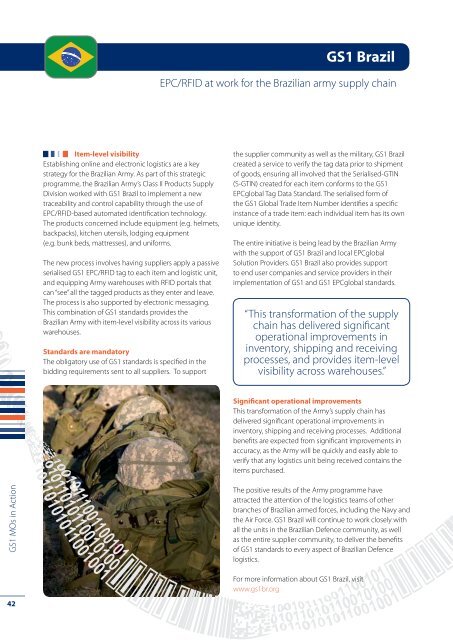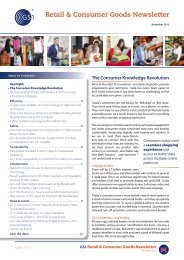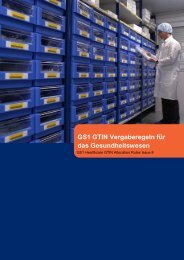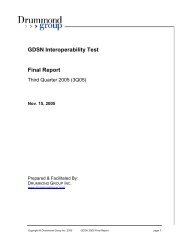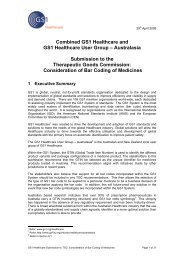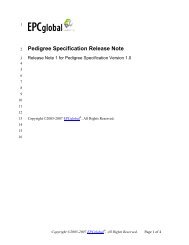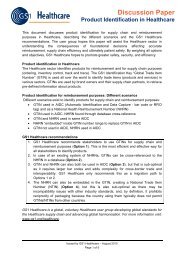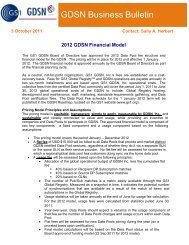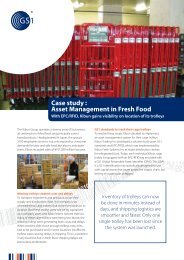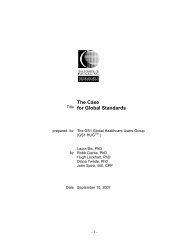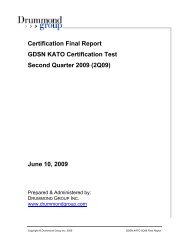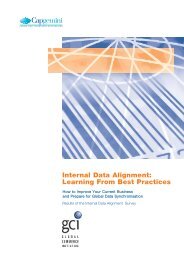Annual Report 2009-2010 - GS1
Annual Report 2009-2010 - GS1
Annual Report 2009-2010 - GS1
Create successful ePaper yourself
Turn your PDF publications into a flip-book with our unique Google optimized e-Paper software.
<strong>GS1</strong> Brazil<br />
EPC/RFID at work for the Brazilian army supply chain<br />
Item-level visibility<br />
Establishing online and electronic logistics are a key<br />
strategy for the Brazilian Army. As part of this strategic<br />
programme, the Brazilian Army’s Class II Products Supply<br />
Division worked with <strong>GS1</strong> Brazil to implement a new<br />
traceability and control capability through the use of<br />
EPC/RFID-based automated identification technology.<br />
The products concerned include equipment (e.g. helmets,<br />
backpacks), kitchen utensils, lodging equipment<br />
(e.g. bunk beds, mattresses), and uniforms.<br />
The new process involves having suppliers apply a passive<br />
serialised <strong>GS1</strong> EPC/RFID tag to each item and logistic unit,<br />
and equipping Army warehouses with RFID portals that<br />
can “see” all the tagged products as they enter and leave.<br />
The process is also supported by electronic messaging.<br />
This combination of <strong>GS1</strong> standards provides the<br />
Brazilian Army with item-level visibility across its various<br />
warehouses.<br />
Standards are mandatory<br />
The obligatory use of <strong>GS1</strong> standards is specified in the<br />
bidding requirements sent to all suppliers. To support<br />
the supplier community as well as the military, <strong>GS1</strong> Brazil<br />
created a service to verify the tag data prior to shipment<br />
of goods, ensuring all involved that the Serialised-GTIN<br />
(S-GTIN) created for each item conforms to the <strong>GS1</strong><br />
EPCglobal Tag Data Standard. The serialised form of<br />
the <strong>GS1</strong> Global Trade Item Number identifies a specific<br />
instance of a trade item: each individual item has its own<br />
unique identity.<br />
The entire initiative is being lead by the Brazilian Army<br />
with the support of <strong>GS1</strong> Brazil and local EPCglobal<br />
Solution Providers. <strong>GS1</strong> Brazil also provides support<br />
to end user companies and service providers in their<br />
implementation of <strong>GS1</strong> and <strong>GS1</strong> EPCglobal standards.<br />
“This transformation of the supply<br />
chain has delivered significant<br />
operational improvements in<br />
inventory, shipping and receiving<br />
processes, and provides item-level<br />
visibility across warehouses.”<br />
Significant operational improvements<br />
This transformation of the Army’s supply chain has<br />
delivered significant operational improvements in<br />
inventory, shipping and receiving processes. Additional<br />
benefits are expected from significant improvements in<br />
accuracy, as the Army will be quickly and easily able to<br />
verify that any logistics unit being received contains the<br />
items purchased.<br />
<strong>GS1</strong> MOs in Action<br />
The positive results of the Army programme have<br />
attracted the attention of the logistics teams of other<br />
branches of Brazilian armed forces, including the Navy and<br />
the Air Force. <strong>GS1</strong> Brazil will continue to work closely with<br />
all the units in the Brazilian Defence community, as well<br />
as the entire supplier community, to deliver the benefits<br />
of <strong>GS1</strong> standards to every aspect of Brazilian Defence<br />
logistics.<br />
For more information about <strong>GS1</strong> Brazil, visit<br />
www.gs1br.org<br />
42


